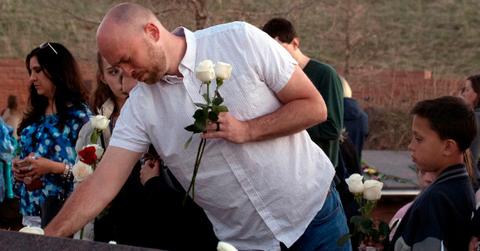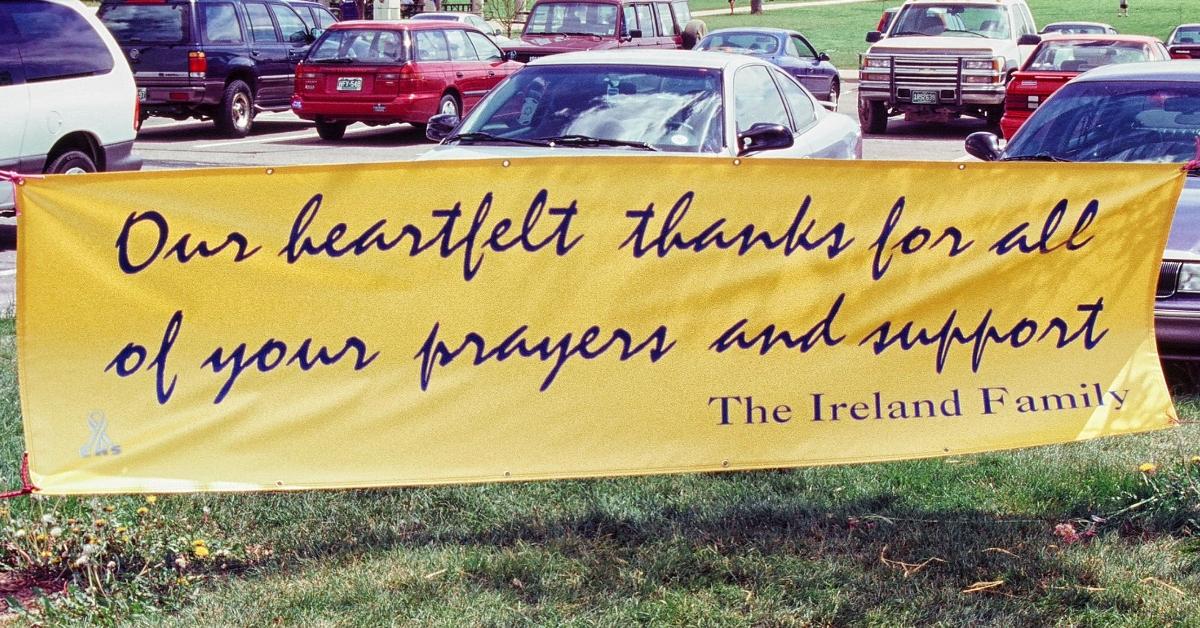Survivors of the Columbine Shooting Carry That Burden With Them Always — Where Are They Now?
Some became advocates, others became addicts, a few are raising children of their own, but every Columbine survivor was changed.
Published April 17 2024, 6:38 p.m. ET

A former Columbine student places flowers at the memorial in Colorado
According to the New York Post, Columbine High School reopened its doors on Aug. 16, 1999. This was almost four months after two students, Dylan Klebold and Eric Harris, shot and killed 13 people. When they had finished with their plan, both Klebold and Harris turned their guns on themselves. On the day students returned to the school, those who had been shot and lived were particularly anxious.
Mark Kintgen was shot multiple times in his head in neck while cowering in library, where most of the damage was done. Ten of the 13 kids who lost their lives were in the library. Kintgen's mother told the outlet that the day her son finally went back to school, he was more concerned about other classmates falling apart. It has been over two decades since that day changed so many lives both in and out of the school. The survivors live with it daily, almost as if it rearranged their DNA.

A banner made by the family of Columbine survivor Patrick Ireland
Where are the Columbine survivors today?
Every person who was at Columbine High School on April 20, 1999, is a survivor. Not a single human walked out of that building without a piece of the tragedy firmly lodged into their hearts. Although Klebold and Harris took 13 lives, they shot 37 people total. Some of those survivors have chosen to remain private, and who could blame them. More than a few have popped up in the news from time to time, giving people a brief glimpse into their lives.
Sean Graves was 15 at the time of the shooting and was hit in his back and stomach, rendering him partially paralyzed. He spoke with USA Today in April 2019, ahead of the 20th anniversary, and told the outlet he still has nightmares. At the time of the interview, Graves's daughter was 3 years old and he spoke about his fear of losing her to a shooting. Graves turned his trauma into advocacy and speaks to "law enforcement groups about the importance of school safety," per the outlet. He and his family live six miles from the school.
Stephen Austin Eubanks was shot multiple times in his head and knee. The Guardian reported that Eubanks was given opioids for the pain, which led him down the path of addiction. It only took months for him to start "manipulating doctors for more prescription medication, then moving on to other drugs," per the outlet. After a decade Eubanks got sober, which gave birth to speaking engagements about the "connection between violence, trauma, and the opioid epidemic." Sadly he overdosed a month after the 20th anniversary.
Richard Castaldo was eating lunch with a friend when he was hit with "five gunshot wounds to his chest, back, arm, and colon," and ended up with "two punctured lungs, a pierced spleen, and a wounded kidney," per 9 News. This would leave him paralyzed and in a wheelchair. In February 2020 the outlet reported that Castaldo was homeless after being evicted from his apartment in 2019. He also recently had a Mersa infection but could not be released from the hospital as a homeless man. Castaldo was transferred to a convalescent center.
Like Castaldo, Anne Marie Hochhalter was left paralyzed by her injuries. In 2016 Westword magazine shared bits and pieces of Hochhalter's communication over the years. She was always very particular when it came to speaking about Columbine. Hochhalter revealed that she lived with a great deal of pain, and was often tormented by sensational media surrounding the tragedy. One thing that did touch her was a letter Dylan Klebold's parents wrote her in the months following the shooting. She described it as "genuine and personal."
Another victim trapped in the library was Makai Hall who was one of the first people shot, per UC Health. He also watched his friend Patrick Ireland get shot in the head. Ireland lived and would go on to be known as the "boy in the window." Because of his time spent in the hospital being cared for by doctors and nurses, Hall decided to become a nurse. "I feel that I’m able to comfort somebody," he said.
Hall's friend Patrick Ireland, who was shot while attempting to help other students, leapt out of a window that day after crawling past the bodies of his fellow students. His wounds left him with a limp and permanent damage to his right hand. He told the Mirror that seven months of physical therapy was like "elementary school again." This didn't stop him from studying "business finance at Colorado State University where he met his wife on the first day," per the outlet. They share three children together.
Lance Kirklin was walking outside when he was shot at point blank range, which destroyed half of his jaw. He was then shot in both legs and his chest. He told PBS that he was more or less fine until 2015, when he bought a new business which contributed to his stress. The single father turned to drinking which eventually brought him to a treatment center. He also found therapy which has given Kirklin some semblance of peace, and hope for a better future.
At one point, one of the shooters pointed a gun at Evan Todd's head and said, "Why shouldn't we kill you?" Mercifully they did not but he was wounded, per NPR for Northern Colorado. He now believes having a gun is the best protection. "A firearm would have saved lives at Columbine," he told the outlet. Becoming a father solidified his views on guns which is why he thinks people should be allowed to carry them on school grounds. Todd said he has "seen evil in this world, and ignoring it never does anything."